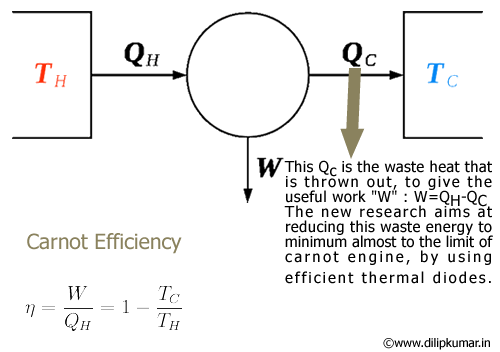An efficient way to produce power from waste heat : MIT
 |
| About 60 percent of all the energy produced by burning fuels or generated in powerplants is wasted, mostly as excess heat |
You might have read in physics, the carnot law - which says however hard you may try you can't convert al heat into energy and sets a theoritical limit on the efficiency of conversion of heat into energy. All modern/ancient/medival (any era's) heat engines efficiency is far less than that.May be some one-tenth of the limit set by carnot efficiency. Now MIT students say their research can lead to an efficiency upto 90 % of carnot limit confirmed by experiments involving a different new technology, thermal diodes (demonstrated upto 40% of carnot eficiency as of now).
In everything from computer processor chips to car engines to electric powerplants, the need to get rid of excess heat creates a major source of inefficiency. But this new research points the way to a technology that might make it possible to harvest much of that wasted heat and turn it into usable electricity.
That kind of waste-energy harvesting might, for example, lead to cellphones with double the talk time  , laptop computers that can operate twice as long before needing to
be plugged in
, laptop computers that can operate twice as long before needing to
be plugged in  , or power plants
that put out more electricity
, or power plants
that put out more electricity  for a
given amount of fuel , says Peter Hagelstein(an associate professor of electrical engineering at MIT
) , co-author of a paper on the new concept appearing this month in the Journal of Applied Physics.
for a
given amount of fuel , says Peter Hagelstein(an associate professor of electrical engineering at MIT
) , co-author of a paper on the new concept appearing this month in the Journal of Applied Physics.
Hagelstein, Wu and others started from scratch rather than trying to improve the performance of existing devices. They carried out their analysis using a very simple system in which power was generated by a single quantum-dot device — a type of semiconductor in which the electrons and holes, which carry the electrical charges in the device, are very tightly confined in all three dimensions. By controlling all aspects of the device, they hoped to better understand how to design the ideal thermal-to-electric converter.
When this work began around 2002, Hagelstein says, such devices “clearly could not be built. We started this as purely a theoretical exercise.” But developments since then have brought it much closer to reality.
“There’s a gold mine in waste heat, if you could convert it,” he says. The first applications are likely to be in high-value systems such as computer chips, he says, but ultimately it could be useful in a wide variety of applications, including cars, planes and boats. “A lot of heat is generated to go places, and a lot is lost. If you could recover that, your transportation technology is going to work better.”
By such an improvement the amount of fuel required to be burnt for fuelling our daily can reduce, thereby improving our environment. Lets hope this technology commercializes soon.
Comments Please
